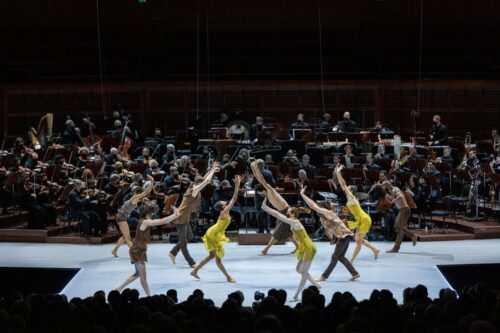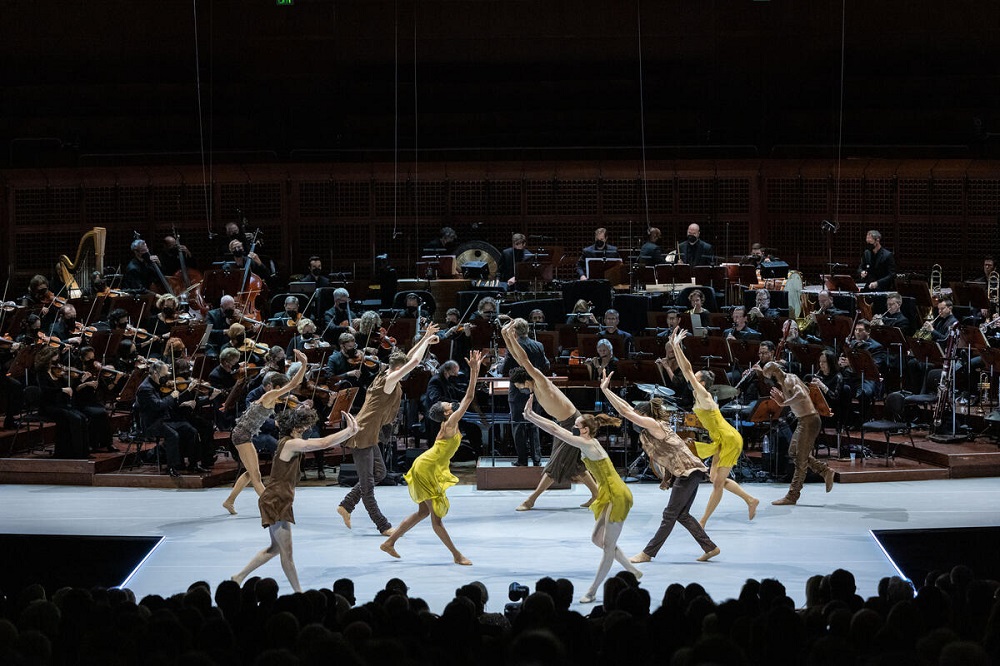 United States San Francisco Symphony’s ‘Re-Opening Night’: esperanza spalding (bass and vocals), Leo Genovese (piano), Terri Lyne Carrington (drums), Ravi Coltrane (tenor sax), dancers from Alonzo King LINES Ballet, San Francisco Symphony / Esa-Pekka Salonen (conductor). Davies Symphony Hall, San Francisco, 1.10.2021. (HS)
United States San Francisco Symphony’s ‘Re-Opening Night’: esperanza spalding (bass and vocals), Leo Genovese (piano), Terri Lyne Carrington (drums), Ravi Coltrane (tenor sax), dancers from Alonzo King LINES Ballet, San Francisco Symphony / Esa-Pekka Salonen (conductor). Davies Symphony Hall, San Francisco, 1.10.2021. (HS)

Adams – Slonimsky’s Earbox
Ginastera – Estancia Suite
Wayne Shorter – Gaia
Revueltas – ‘Noche de encantamiento’ from La noche de los Mayas
Big, bold, bumptious and brash, the energy generated by Esa-Pekka Salonen’s formal debut as music director launched San Francisco Symphony’s ‘Re-Opening Night’ (as the 2021 opening night was promoted) explosively. The fired-up orchestra, playing rambunctious music composed in the past century, drew a thunderous response from a clearly dazzled audience.
Salonen conducted a few concerts last spring, when the orchestra took tentative steps to welcome live audiences into Davies Symphony Hall with programs using limited resources. But this one filled the stage with more than 100 musicians and dancers. It felt like a statement of purpose.
Even though Salonen’s predecessor as music director, Michael Tilson Thomas, had primed audiences to welcome music written after the nineteenth century, previous gala opening nights did not embrace such raucous pieces as Alberto Ginastera’s Estancia Suite or Silvestre Revueltas’ percussion-heavy ‘Noche de encantamiento’ (from his score to the 1939 Mexican film La noche de los Mayas).
Nor have San Francisco Symphony audiences heard anything quite like Gaia, a 30-minute opus by the octogenarian jazz artist Wayne Shorter. The centerpiece of the evening, it featured the extraordinary bassist and vocalist (and lower-case name advocate) esperanza spalding. That was a very different experience than the opera and Broadway stars whose appearances in previous openers delivered mostly familiar songs.
Rhythm, this time, provided the glue that held the program together.
The orchestra kicked off the evening with John Adams’s 1995 Slonimsky’s Earbox, premiered in Manchester, England, in 1996 by the Hallé Orchestra under Kent Nagano. Unlike Adams’s minimalist-infused earlier works, this marked a welcome turn toward more pungent harmonies. The piece’s driving rhythms owe much to Stravinsky (especially Le Chant du Rossignol, which Adams cites as the main inspiration). In the pulsing opening measures, an army of brass lit up the sound as brightly as the colors of the ever-changing lighting did visually.
Earbox is also a virtuosic piece, and the outsized forces of the orchestra played it with remarkable precision and energy, something that spanned the entire evening.

The visuals got exponentially better with Ginastera’s four-part ballet, performed with athleticism and controlled abandon by the Alonzo King LINES Ballet. The San Francisco-based dance company fielded a crew of nine that performed on a thrust stage in front of the orchestra. Underlining the synergy between dancers and orchestra, Salonen took his cues from the dancers to begin each movement, which alone created some beautiful moments.
The musical power in this ballet came from the combination of rhythmic energy and rigorous execution by the orchestra. The finale, ‘Malambo,’ a familiar encore that requires vitality from an orchestra, included some of the most impressive dancing as well. The audience roared in appreciation.
Gaia debuted in 2013 with spalding and Shorter himself performing with the Los Angeles Philharmonic. (This was after Salonen had left his position there as music director.) Even with tenor saxophonist Ravi Coltrane, pianist Leo Genovese and drummer Terri Lyne Carrington joining her, there was a surprising lack of improvisation. Shorter’s slow-moving, unrelentingly massive score wore thin after Carrington’s third of many repetitions of the main theme.
There is no denying the savory beauty of spalding’s polished voice, especially as it rose into the highest register, but it was the same musical phrases again and again. Gestures combining her bass with low brass and woodwind instruments created pleasing moments, but despite amplification it was impossible to make our more than about ten percent of the words she sang.
The evening’s finale revved things up again. Revueltas’s rugged, raw score spotlighted the orchestra’s percussion section, which drove home the ever-evolving rhythms while the brass punched chords. Woodwinds wound sinuous phrases through it all.
Great stuff, and it was all captured for television, to be broadcast on PBS’s Great Performances (premiering on 19 November).
Harvey Steiman
